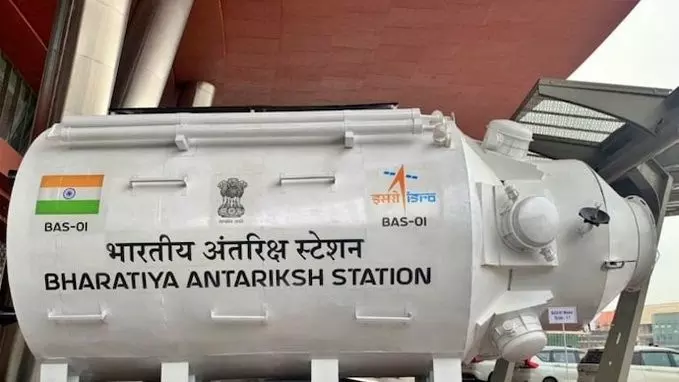
ISRO gives a glimpse of Bharatiya Antariksh Station: Check details
The Indian Space Research Organisation (ISRO) aims to launch the first module of the project by 2028, and the full station is expected to become operational by 2035

ISRO has unveiled a model of the Bharatiya Antariksh Station (BAS) module during the National Space Day celebrations at Bharat Mandapam in New Delhi.
The first module of BAS, India’s maiden home-built space station, is aimed at positioning the country among a select few operating orbital laboratories.
The Indian Space Research Organisation (ISRO) aims to launch the first module of the project by 2028, and the full station is expected to become operational by 2035.
Also Read: National Space Day 2025: Significance, theme and what ISRO, PM Modi said
BAS-01 model
A massive BAS-01 model, measuring 3.8 metres in diameter and 8 metres in length, was the star attraction at the National Space Day event.
Currently, only two such stations are functional, including the International Space Station (ISS), jointly managed by five space agencies, and China’s Tiangong space station.
As part of its long-term vision, India plans to assemble five BAS modules by 2035 under its expanding space programme.
The first unit, BAS-01, will weigh about 10 tonnes and orbit at an altitude of 450 km in low Earth orbit.
Cutting-edge indigenous features
The station will be equipped with several indigenously developed features, including an Environmental Control and Life Support System (ECLSS), Bharat Docking System, Bharat Berthing Mechanism, automated hatch systems, platforms for microgravity research and technology demonstration, as well as viewports designed for scientific imaging and crew recreation.
The BAS will also have provision for refilling of propulsion and ECLSS fluids, radiation, thermal and Micro Meteoroid Orbital Debris (MMOD) protection.
Other features include space suits, airlocks to support extra vehicular activity and plug and play integrated avionics.
India's journey to establish its own orbital laboratory marks a major leap in its space program and reinforces its position as a global leader in space exploration.
Also Read: PM Modi urges scientists to prepare for deep space mission on National Space Day
Hub for research
Once operational, BAS will serve as a research hub for space science, life sciences, medicine, and interplanetary exploration.
It will enable scientists to study the effects of microgravity on human health while testing essential technologies critical for long-term human presence in space.
Beyond research, the station is expected to pave the way for space tourism, with India aiming to tap into the commercial space sector through its orbital lab.
In addition to fostering international collaboration, the BAS is expected to inspire future generations to take up careers in space science and technology.
Also Read: Shubhanshu Shukla says ISS mission aids Gaganyaan, Antariksh plans
India to match global space powers
ISRO chief V Narayanan emphasised that by 2035, India will lift off the first module of BAS.
He stated that India will land on the moon by the year 2040, which will make India's space programme the top other than any country in the world.
The ISRO chairman also announced that India will launch the Chandrayaan 4 mission, which will have the Venus Orbiter Mission.
"We are going to have a space station called BAS (Bharatiya Antriksh Station) by 2035, and the first module will be lifted off by 2028. By 2040, India will land on the moon and we are going to bring back safely. Thereby by 2040, Indian space programme will be at par with any other space programme of the world," the ISRO chief said.

